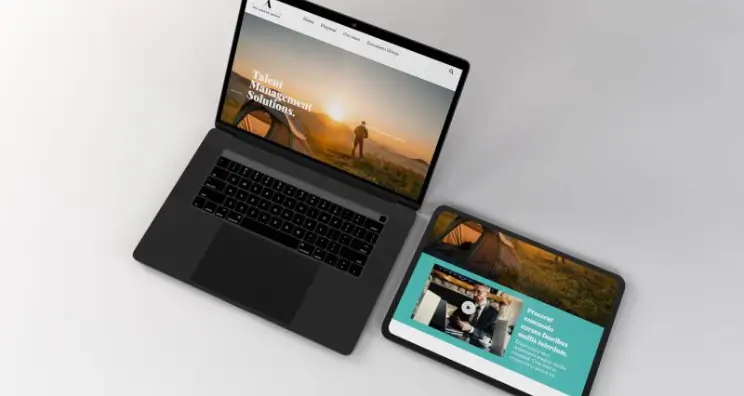Creating a strong brief is a key part of the design process. But what is a design brief, and how can you ensure that yours is good enough for your designers to deliver the best results possible?
In this guide, we set out what you need to know to create a strong design brief. By creating the best brief you can, you’ll empower your designers to deliver their best work. And great design means a more effective sales proposal, which can mean better sales figures.
Let’s get started.
What is a design brief?
Used by marketing agencies, freelance managers, and creative teams around the world, design briefs are a set of instructions to guide the creation of visual assets.
What counts as a visual asset? The possibilities range from videos to infographics and from sales presentations to audiobook covers. In this guide, we focus on design briefs for digital sales proposals.
Specifically, we focus on digital sales proposals in the form of secure microsites – our bread and butter at Zoomforth.
We’ve discussed the importance of having design resources as part of your content experience team before. We’ve also shown how designers can be leveraged to ensure that sales proposal microsites are designed with the latest UX (User Experience) in mind.
Why quality design briefs are important
Writing a strong brief ensures that you get the best possible work out of your design team.
Why?
Because designers with only vague instructions to follow are unlikely to deliver on your expectations. By contrast, clear instructions can mean designers know exactly what you’re expecting, giving them a clear route to success.
Additionally, if you’re working with freelance designers, a written design brief gives them a single place to go for all the information they need relating to your project.
This is important because half-remembered phone calls, long email chains and a collection of WhatsApp messages tend to get lost in the mix. On the other hand, a single written set of instructions makes sure that designers can easily refer to the necessary information and stay faithful to your vision.
What’s the objective of a design brief?
In addition to specifying the deliverables, a design brief should cover the following areas:
- The context of work to be completed
- The purpose of the specific project
Why?
Whether you’re dealing with a freelance writer or an in-house graphic designer, it’s essential that you provide the overall context of the project that they’re working on.
To illustrate, let’s consider an example most people are more familiar with. A freelance writer needs to know the key points to cover in an article. But they’ll do better work if they understand the context of the article within the campaign they’re working on.
There are two main reasons for this.
- Nobody likes feeling like a cog in the wheel. Open up to your graphic design team about exactly what you’re hoping to achieve with their design work. This context can help them do the best job possible.
- Knowing the purpose of the campaign can result in differences in design considerations. If the microsite is being developed as part of a bid by a professional services firm to win business from a major local bank, that has clear design implications.
In this case, designers might be encouraged to include imagery that reassures, colors and fonts that suggest permanence and dependability, and an overall aesthetic in line with traditional corporate values.
The type of prospect being pursued might have an impact on design considerations. A proposal that is being sent to a single person could be designed for easy scrollability with almost all the information conveyed over one page.
By contrast, a sales proposal being pitched to an entire committee might need to facilitate easy navigation so that different stakeholders can quickly jump to the parts that are most likely to be of interest to them.
Trying to communicate the specific objectives of your sales proposal might prove a useful clarifying exercise. Some top-level questions that can be useful in making it clear for yourself include:
- What action(s) do I want the reader to take after reading this digital sales proposal?
- Is this microsite being targeted at a marketing qualified lead (MQL) or a sales qualified lead (SQL)?
- How many people are on the purchasing committee?
There’s no need to go overboard. A couple of lines about what this microsite is supposed to achieve can help the design team feel like valued members in an inclusive, collaborative team while boosting your chances of a successful bid.
Who’s the target audience?
In addition to knowing what the purpose of the microsite is, designers need to know who the intended target readership is.
We’ve discussed before how microsites can be used for account based marketing (ABM) workflows and how they can be developed iteratively to reflect the needs and interests of your prospects.
The beauty of a microsite-based sales proposal is that, unlike a static document, it can be updated continuously as the target audience evolves or more data becomes available.
One of the key fields in the design brief is knowing exactly who the target readership is. While demographic information such as the likely age of the buying committee may be helpful, their professional background, experience, and industry is likely to be more useful.
For instance, you could let your design team know that the sales proposal is being sent to a senior procurement committee at a major Fortune 500 enterprise. Each team member might have 10 years experience in the industry. Based on this information, a more corporate design could be optimal.
But why is this helpful to designers?
 Do you need specific changes for different device types? Don’t forget to specify this in your design brief.
Do you need specific changes for different device types? Don’t forget to specify this in your design brief.
Why designers want to know your audience
Based on the information you supply, the design team could look at examples of other bids that have been sent in order to understand what look and feel this kind of target audience typically expects.
If the bid is being sent in response to an RFP, there might be formal requirements and these should be integrated into the design.
Or perhaps the proposal is being sent by a design firm bidding for a web design project to an IT firm. Again, in this case, the target’s industry (IT) and the expected reader could all influence the eventual design.
A good design team will put into consideration what kind of site design and layout are popular with readers in the IT industry. In turn, this could influence factors such as:
- The site’s typography
- Whether to focus on a primarily visual or textual layout
- The UX elements of the site
What creative assets are already available?
It might be hard to believe, but many companies working with designers forget to take advantage of the existing creative assets that they already have ready-to-go in house.
Before you have your design team reinvent the wheel, don’t forget to pass on any resources that may assist them with the project. This could be things such as:
- Access to a stock image library
- Pre-existing illustrations, graphs, tables, or infographics
- Company logos
- Videos
- Other internal IP
If you’re graphic design savvy then you might already know the difference between raster and vector-based graphics. If you frequently work with design teams to prepare microsite sales proposals, then you might wish to develop an extensive design library filled with every permutation of your official imagery and any graphics that a designer might require.
Consider offering designers:
- Raster and vector-based versions of key company IP such as your official logo
- Black, white, and color versions of the same
- A headshot library of your leadership team. Or your team in general.
What USPs are being pitched?
We talked previously about the players you might need in your proposal A-team. If a writer is part of the design team, you’ll want to make sure that he or she has a comprehensive brief separate from the design team’s.
Often, where the writer’s work ends, the graphic design team’s begin. For that reason, it makes sense to keep both appraised of the textual messaging objectives for this microsite project.
Copy should be laid out in a fashion that lends itself to highlighting the points that need to be highlighted. And these points are the core selling points which the sales proposal is designed to get across to its readership.
Key design principles for presenting text include:
- Make the text containing the most important information more prominent
- Use bold and italics where necessary to emphasize key words and phrases
- Use textual design elements like pull quotes where appropriate to draw readers’ attention to things like testimonials and user quotes
- Traditionally, web writers have been taught to include the most important information within the part of the site that first loads on readers’ screens (above the fold). While this isn’t an actual law, it still makes sense to try to lay out important information towards the top of the page.
What are the brand guidelines?
Many companies have developed branding guidelines which specify exactly how their brand and company should be communicated visually. These can be quite specific in their requirements.
Branding guidelines can set:
- What the official typography of the company is
- What the official versions of the company logo are
- The company’s color palette. This typically specifies precisely which shades and colors can be used for any official company communication, including marketing content and microsites
- The amount of white space that must surround elements such as text, logos, and other images
- What imagery cannot be included, such as representations of violent acts or political material
Additionally, many companies have editorial style guides which aim to standardize the company’s official “tone of voice” for written communication.
For companies, using a style guide helps ensure that every communication emanating from the company looks and sounds about the same to ensure a consistent brand experience.
For companies that are using microsites to pitch for business in an industry, or even to pitch the same company multiple times, brand standardization is a central requirement with important benefits.
Brand standardization is associated with perceptions of professionalism among target audiences. After all, if your company has a clear idea of how it would like to be portrayed, and ensures consistency, it must have a clear vision and good internal organization.
Create templates using Zoomforth
One of the Zoomforth features which customers love is the ability to set up templates for rolling our microsites.
After saving a site as a template, users can quickly roll out iterations of the one microsite which has been hard baked with brand conformity in mind. This simplifies the process of ensuring that brand guidelines are adhered to every time.
Other design brief elements
To make sure that your creative design brief is as effective as possible, provide as much information as the design team might need without overwhelming them by providing too much. A concise brief is the aim.
Some key elements which might be needed to create effective microsites for digital sales proposals include:
- Due date: Teams tend to work best when there is a hard deadline for when the work needs to be completed. Make sure your designers know what date the site needs to be sent to the sales prospect by. Depending on your internal workflow, you might want to leave a day or two before to allow for internal review.
- Milestones: Building a microsite can be a complex project. Teams also tend to perform better in big projects when they’re broken down into small milestones. You might want to do the same in your brief, setting out dates by which certain aspects of the site design need to be completed.
You should also consider sharing:
- Inspiring examples: Sometimes the easiest way to help a design team get a feel for your taste and what you’re trying to achieve is to point to samples of work that you saw before and liked. These could be some of your own previous microsite builds or even competitor websites.
Of course, you’ll also want to provide the designers with the navigation structure, pages, and copy that you want included on each page. You can use wireframes to give your team a visual mockup of the kind of site you want to see designed.
If you’re not familiar with this concept, then Google ‘wireframing tools’. Free tools are available for every major operating system.
Don’t forget to mention any UX rules that are particularly important to you. If you need a refresher on which ones we recommend, then check out this post. If avoiding empty grid columns is a top priority for you, then make sure to get that across in the brief.
Better briefs, better digital sales proposals
The amount of information that you might need to include in a design brief might seem overwhelming, but clarifying expectations from the outset is a great way to streamline the development process and minimize the amount of time that subsequently needs to be spent on revisions.
A good design brief provides a creative vision for what kind of microsite you think is most likely to win over your sales proposal. Provide the detail required for your designers to get the job done in the best possible manner. Then, iterate and repeat.
Create interactive, trackable and secure sales proposals with Zoomforth.



